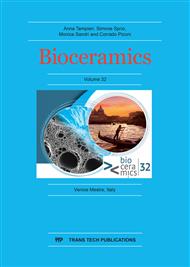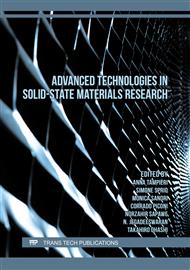[1]
H. Oonishi, Orthopaedic applications of hydroxyapatite, Biomaterials 12 (1991) 171-178.
Google Scholar
[2]
R. Petit, The use of hydroxyapatite in orthopaedic surgery: A ten-year review, Eur. J. Orthop. Surg. Traumatol. 9 (1999) 71-74.
DOI: 10.1007/bf01695730
Google Scholar
[3]
B. Zhang, X. Pei, P. Song, H. Sun, H. Li, Y. Fan, Q. Jiang, C. Zhou, X. Zhang, Porous bioceramics produced by inkjet 3D printing: Effect of printing ink formulation on the ceramic macro and micro porous architectures control, Composites Part B 155 (2018) 112-121.
DOI: 10.1016/j.compositesb.2018.08.047
Google Scholar
[4]
H. Sun, C. Hu, C. Zhou, L. Wu, J. Sun, X. Zhou, F. Xing, C. Long, Q. Kong, J. Liang, Y. Fan, X. Zhang, 3D printing of calcium phosphate scaffolds with controlled release of antibacterial functions for jaw bone repair, Mater. Des. 189 (2020) 108540.
DOI: 10.1016/j.matdes.2020.108540
Google Scholar
[5]
C. Shuai, C. Gao, Y. Nie, H. Hu, H. Qu, S. Peng, Structural design and experimental analysis of a selective laser sintering system with nano-hydroxyapatite powder, J. Biomed. Nanotechnol. 6 (2010) 370-374.
DOI: 10.1166/jbn.2010.1139
Google Scholar
[6]
C. Schmidleithner, S. Malferarri, R. Palgrave, D. Bomze, M. Schwentenwein, D.M. Kalaskar, Application of high resolution DLP stereolithography for fabrication of tricalcium phosphate scaffolds for bone regeneration, Biomed. Mater. 14 (2019) 045018.
DOI: 10.1088/1748-605x/ab279d
Google Scholar
[7]
H.K. Lim, S.J. Hong, S.J. Byeon, S.M. Chung, S.W. On, B.E. Yan, J.H Lee, S.H. Byun, 3D-Printed ceramic bone scaffolds with variable pore architectures, Int. J. Mol. Sci. 21 (2020) 6942.
DOI: 10.3390/ijms21186942
Google Scholar
[8]
M. Schwentenwein, P. Schneider, J. Homa, Lithography-based ceramic manufacturing: A novel technique for additive manufacturing of high-performance ceramics, Advances in Science and Technology 88 (2014) 60-64.
DOI: 10.4028/www.scientific.net/ast.88.60
Google Scholar
[9]
A.D. Lantada, A.D.B. Romero, M. Schwentenwein, C. Jellinek, J. Homa, Lithography-based ceramic manufacture (LCM) of auxetic structures: present capabilities and challenges, Smart Mater. Struct. 25 (2016) 054015.
DOI: 10.1088/0964-1726/25/5/054015
Google Scholar
[10]
F.J. O'Brien, Biomaterials and scaffolds for tissue engineering, Mater. Today 14 (2011) 88-95.
Google Scholar
[11]
C.M. Murphy, F.J. O'Brien, D.G. Little, A. Schindeler, Cell-scaffold interactions in the bone tissue engineering triad, European Cells and Materials 26 (2013) 120-132.
DOI: 10.22203/ecm.v026a09
Google Scholar
[12]
J.Y. Buffière, E. Maire, J. Adrien, J.P. Masse, E. Boller, In situ experiments with X-ray tomography: An attractive tool for experimental mechanics, Exp. Mech. 50 (2010) 289-305.
DOI: 10.1007/s11340-010-9333-7
Google Scholar
[13]
A.G. Evans, E.A. Charles, Fracture toughness determination, J. Am. Soc. 59 (1976).
Google Scholar
[14]
ASTM C1424-15, Standard Test Method for Monotonic Compressive Strength of Advanced Ceramics at Ambient Temperature, Annual Book of ASTM Standards, ASTM International, West Conshohocken, PA, (2015).
Google Scholar
[15]
C. Benaqqa, J. Chevalier, M. Saadaoui, G. Fantozzi, Slow crack growth behaviour of hydroxyapatite ceramics, Biomaterials 26 (2005) 6106-6112.
DOI: 10.1016/j.biomaterials.2005.03.031
Google Scholar
[16]
C. Shuai, P. Li, J. Liu, S. Peng, Optimization of TCP/HAP ratio for better properties of calcium phosphate scaffold via selective laser sintering, Materials characterization 77 (2013) 23-31.
DOI: 10.1016/j.matchar.2012.12.009
Google Scholar
[17]
M.S. Barabashko, M.V. Tkachenko, A.A. Neiman, A.N. Ponomarev, A.E. Rezvanova, Variation of Vickers microhardness and compression strength of the bioceramics based on hydroxyapatite by adding the multi-walled carbon nanotubes, Appl. Nanosci. 10 (2020) 2601-2608.
DOI: 10.1007/s13204-019-01019-z
Google Scholar
[18]
D.M. Liu, Preparation and characterisation of porous hydroxyapatite bioceramic via slip-casting route, Ceramics International 24 (1998) 441-446.
DOI: 10.1016/s0272-8842(97)00033-3
Google Scholar
[19]
D.S. Metsger, M.R. Rieger, D.W. Foreman, Mechanical properties of sintered hydroxyapatite and tricalcium phosphate ceramic, J.Mater.Sci: Materials in medicine 10 (1999) 441-446.
Google Scholar
[20]
P. Miranda, A. Pajares, E. Saiz, A.P. Tomsia, F. Guiberteau, Mechanical properties of calcium phosphate scaffolds fabricated by robocasting, J. Biomed. Mater. Res. A 85 (2008) 218-227.
DOI: 10.1002/jbm.a.31587
Google Scholar
[21]
E. Giesen, M. Ding, M. Dalstra, T. Van Eijden, Mechanical properties of cancellous bone in the human mandibular condyle are anisotropic, J. Biomech. 34 (2001) 799-803.
DOI: 10.1016/s0021-9290(01)00030-6
Google Scholar
[22]
AA. White, SM. Best, IA Kinloch, Hydroxyapatite–carbon nanotube composites for biomedical applications, Int. J. Appl. Ceram. Technol. 4 (2007) 1-13.
Google Scholar
[23]
D.M. Liu, Control of pore geometry on influencing the mechanical property of porous hydroxyapatite bioceramic, J. Mater. Sci. Lett. 15 (1996) 419-442.
DOI: 10.1007/bf00277185
Google Scholar
[24]
T.M.G. Chu, D.G. Orton, S.J. Hollister, S.E. Feinberg, J.W. Halloran, Mechanical and in vivo performance of hydroxyapatite implants with controlled architectures, Biomaterials 23 (2002) 1283-1293.
DOI: 10.1016/s0142-9612(01)00243-5
Google Scholar
[25]
P. Miranda, A. Pajares, E. Saiz, A.P. Tomsia, F. Guiberteau, Fracture modes under uniaxial compression in hydroxyapatite scaffolds fabricated by robocasting, J. Biomed. Mater. Res. A 83 (2007) 646-655.
DOI: 10.1002/jbm.a.31272
Google Scholar
[26]
J. Roleček, L. Pejchalová, F.J. Martínez-Vázquez, P. Miranda González, D. Salamon, Bioceramic scaffolds fabrication: Indirect 3D printing combined with ice-templating vs. robocasting, J. Eur. Ceram. Soc. 39 (2019) 1595-1602.
DOI: 10.1016/j.jeurceramsoc.2018.12.006
Google Scholar



